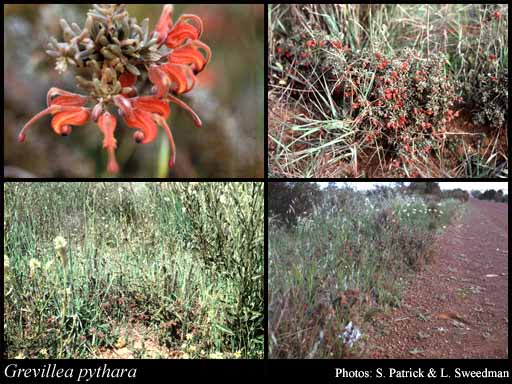- Reference
- Nuytsia 9(2):293-294, Fig.19 (1993)
- Conservation Code
-
Threatened
A taxon name retains its ‘Threatened’ status until a new name has been officially endorsed and appears in the Gazettal Notice.
- Naturalised Status
- Native to Western Australia
- Name Status
- Current
Suckering shrub, 0.06-0.3 m high. Fl. orange & red & blue, May to Oct (possibly all year). Sand or sandy loam with gravel.

Scientific Description
Shrubs, 0.30 m high; branchlets hairy, not glaucous. Leaves alternate, 7-16 mm long, 1.5-4 mm wide, hairy, on the adaxial or abaxial surface, the hairs straight; lamina flat, widest around the middle or clearly widest above the middle, entire, the margins recurved or revolute, exposing the lower surface of the leaf blade. Inflorescences terminal, red; pedicels 5-7 mm long. Perianth 10-15 mm long; tepals some joined and some free after flower opens, hairy, simple-hairy; ovary hairy, stipitate, the stipe 6-7 mm long; pistil 18-20 mm long, red, pollen presenter lateral, style hairy. Follicles glabrous, not viscid, dehiscent. Flowers in May, June, July, August, September or October. Occurs in the South-west (SW) Botanical Province(s), in the Geraldton Sandplains (GS) or Avon Wheatbelt (AW) IBRA subregion(s). : Conservation code Threatened (T).
Distribution
- IBRA Regions
- Avon Wheatbelt, Geraldton Sandplains, Swan Coastal Plain.
- IBRA Subregions
- Lesueur Sandplain, Merredin, Perth.
- Local Government Areas (LGAs)
- Dalwallinu, Perth.